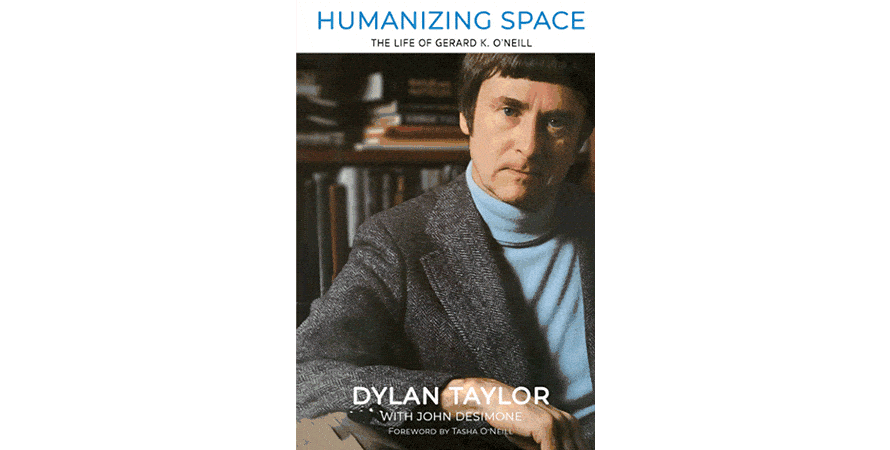Category: Nonfiction
Reviewed by: Clifford R. McMurray
Title: Humanizing Space: The Life of Gerard K. O’Neill
Author: Dylan Taylor with John Desimone
NSS Amazon link for this book
Format: Paperback, Kindle
Pages: 242
Publisher: Multiverse Publishing
Date: April, 2021
Retail Price: $14.99/$9.99
ISBN: 979-8734136751
You don’t have to hang around the space movement for very long before you hear the story of how Gerard O’Neill’s thoughts about space colonies became the catalyst for the first post-Apollo space generation’s aspirational efforts to get humanity off Earth in a big way. Many familiar faces among the NewSpace entrepreneurs, including Jeff Bezos, were O’Neill acolytes in their younger days; some of them still humorously refer to themselves as “Gerry’s Kids.” But there’s much more to O’Neill’s story than the part space nerds are familiar with. His story is, from start to finish, the story of an exceptional mind merged with a sanguine personality, living an exceptional life.
O’Neill learned about service and contribution to society from a young age, growing up the only child of a badly wounded World War I veteran and a mother who volunteered as a nurse in that war (his parents met on a troopship heading home after the war). His father was a prominent lawyer in New York state who led a task force prosecuting racketeering, and who helped draft several amendments to the state constitution. Meeting prominent reform-minded politicians like Governor Al Smith influenced young Gerard to look for ways to make the world better. His contributions to that end wouldn’t be in politics, however. After serving in the Navy at the tail end of World War II, he came home and went to school to become a physicist. He made a great contribution to experimental physics with his revolutionary design for a storage ring synchrotron, which allowed electrons to reach much higher energies before colliding with each other and shattering into their component subatomic particles. Other physicists earned Nobel Prizes using his invention, but there was no Nobel for him. He applied for NASA’s first class of scientist astronauts, but didn’t make the final cut.
His road to fame lay elsewhere, and it began with a question he posed to his undergraduate physics seminar students at Princeton in 1969: “Is the surface of a planet the right place for an expanding technological civilization?” As he and his students explored the question together, they came to an unexpected conclusion. It would be much easier and faster to expand civilization in free space; outside of the gravity wells of planets, large (very large) habitats could be built with lunar and asteroidal material and virtually limitless solar energy. The idea gained urgency in his mind after his encounter with the infamous book Limits to Growth. The authors of that book had concluded that civilization here on Earth was doomed within a few more generations at most, after increasing population used up all the natural resources of our planet. O’Neill’s space colonies offered a way to sidestep doomsday: forget about using Earth’s resources. Move out into the solar system and use its resources instead. Forget about endless dictatorships of impoverished masses. Create limitless variations on human freedom in space instead.
For the remainder of his life, O’Neill pursued this vision with a calm patience. For the first decade he tried to persuade the federal government to fund the first colony as a large government program, but eventually he came to the conclusion that the job would have to be done with private capital. As a means to raise that capital he founded Geostar, which would have offered a GPS service before GPS was even thought of. On the verge of success, he was diagnosed with leukemia. He lasted seven years after this fatal announcement, much longer than anyone expected him to live. Here is where his natural nobility of spirit moved into the realm of heroism. In his twilight years, despite many hospital stays and ever-closer brushes with death, he never stopped fighting to live a good life with his family and do whatever work he could still manage to. Geostar did not survive him. His vision will remain for centuries to come.
Sometimes, when a movement looks back on its founding heroes, it finds they were less than their public image. How grateful the space movement must be to Dylan Taylor and John Desimone for showing us, in this biography, that one of our heroes is not only as good as his image, but much greater.
© 2022 Clifford R. McMurray
Please use the NSS Amazon Link for all your book and other purchases. It helps NSS and does not cost you a cent! Bookmark this link for ALL your Amazon shopping!




















1 thought on “Book Review: Humanizing Space: The Life of Gerard K. O’Neill”
This sounds like a great book! I’m really looking forward to getting it. I met Dr. O’Neill once at an L5 Space Development Conference. We talked about mass drivers, and he was amenable to helping me create my mass driver, but time got away from us. I made an initial one, but at some point the great man passed away, and I graduated. I had a lot to learn, and still do. This will be a nice way to remember him, and maybe some of his other acquaintances, and learn what led him to his great achievements. Off to Amazon.